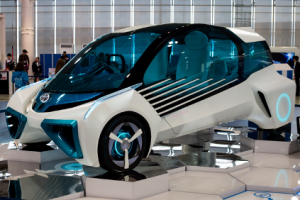Catalysts have been instrumental in human development, especially in producing energy. For over 100 years catalysts have transformed how we get from A to B, and will continue to do so by giving us cleaner greener alternative fuels. So how have energy catalysts developed over time?
By Aditya Sengar, Research Associate in the Department of Bioengineering.
“The Chinese use two brush strokes to write the word crisis. One brush stroke stands for danger; the other for opportunity. In a crisis, be aware of the danger but recognize the opportunity.” The quote by John F. Kennedy, the 35th President of the United States, has stood the test of time and is relevant to the context of the catalysis industry today. Set in motion by the two World Wars, the industry paved the way for the world to transition from a coal-based economy to crude oil-based economy. Now it’s central to the transition away from carbon-intensive fossil fuels.
End of the coal era
The world witnessed the dangers of excessive reliance on coal at the end of the 19th century. Coal burning caused rising air pollution. London recorded the highest air particulate concentration in the 1890s. The commercial exploitation of oil wells from the 1850s meant that this was considered the future of energy during those times.
Crude oil consists of long carbon-chain molecules. These are broken down to smaller chain molecules to make the petroleum products we are familiar with: petrol, diesel and aviation fuels. Thermal cracking, an industry standard until the 1940s, required burning crude oil at high temperatures to produce petroleum products. The process was still dirty. Catalytic cracking, developed and refined in the 1930s in the USA, produced higher-octane fuels. These gave an edge to Allied Forces’ fighter aircraft over their German counterparts during World War II. The process soon replaced thermal cracking in crude oil refineries.
Modern day catalytic cracking involves a catalyst in powder form, with molecular cage-like structures at nanoscales. These energy catalysts hold longer-chain crude oil and provide ion-exchange reactions for an easy breakdown to petroleum products. These catalysts are the result of a long chain of research development throughout the 20th century.

1970s energy crisis
In the 1970s, an energy crisis hit the Western World. With oil supply saturating in Germany, USA and Venezuela, crude oil price rises rose and led to a decade-long economic crisis. The crisis also gave an impetus to public concerns about the environmental effect of burning coal and crude oil. The catalyst industry developed processes for cleaner production of energy using coal, natural gas and oil, or sometimes even replacing them.
Early 20th century energy catalysts
After the First World War, Germany was fulfilling 14% of its energy supply with synthetic liquid fuel. Liquid fuel has the advantage over coal of being much easier to transport. The process to make synthetic fuels was developed by chemists Franz Fischer and Hans Tropsch in the 1920s.
The process faded into obscurity after the discovery of vast crude oil reserves across the world. It was now cheaper to make energy out of oil. The 1970s energy crisis made global powers, then heavily reliant on oil, realize the commercial opportunity provided by the Fischer-Tropsch (FT) process. South Africa produced a high proportion of its transport fuel from coal using FT synthesis.
The FT process works with catalysts called zeolites, with cage-like molecular structures to trap gases like carbon monoxide and hydrogen. These gases react together to produce petroleum products. Modern-day research focuses heavily on reducing emissions of carbon dioxide, a by-product of the process, via another catalytic method known as carbon capture.
Energy catalysts for biofuels
Biofuels are an alternative to crude oil-derived diesel fuels. Many are produced by a catalytic process from vegetable oils, e.g. rapeseed or soybean. These oils react with simple alcohols to form longer carbon chain molecules, the biodiesel. This is not a well-known fact, but the inception of a sustainable energy economy was actually kicked off by biofuels. It was Rudolf Diesel, the inventor of the diesel engine, who first demonstrated an engine running on peanut oil, as early as 1900. The huge discoveries of crude oil reserves in the next few decades killed any early interest in biofuels. Thanks to the 1970s energy crisis, the industry has re-emerged.
The cost of production per unit of energy of biodiesel is similar to that of conventional diesel. However, the calorific value of the biofuel is 10-20% less than that of the fossil diesel. In theory biofuels are carbon neutral, because the absorption of CO2 by the plant during growth balances the emission of CO2 on burning. However, this does not take account of greenhouse gas emissions from farming. Farming for biodiesel increases competition for land and thus raises costs for food production. The Paris Agreement of 2015 makes it binding for the signatories to produce 10-15% of their energy requirements by biofuels in the coming decade, which is not a very ambitious target given the maturity of the technology.
Energy catalysts for fuel cells

Fossil fuels generate two-thirds of the world’s electricity demand. The majority is produced inefficiently by coal and natural gas. Furthermore, the present-day gridlines to supply electricity to our homes and industries result in heavy energy loss. This results in overall low efficiency (about 33%) of converting primary energy source to usable energy.
Enter fuel cells. A fuel cell generates current from a chemical reaction between hydrogen and oxygen over platinum catalyst with 60%+ efficiency. The oxygen comes from the air. Hydrogen production can be ‘blue’ from a natural gas feedstock (via a catalytic process called steam reforming) or ‘green’ produced by splitting water by electrolysis, often directly from solar energy via photocatalysts. The hydrogen is compressed, stored in a tank, and is replenished at a filling station, like petrol. Over the past 15 years, fuel cell cost has fallen by 5 times to about $50/kWh (current costs of conventional internal combustion engines are about $30/kW for light-duty vehicles). Not quite competitive with petrol engines yet, but getting there…
Many different catalysts for many different energy processes
We’ve surveyed a lot of different catalytic processes in this article: for cracking oil, making synthetic fuel, making biodiesel, making hydrogen and capturing CO2 emissions. In our next, we’ll look at the future of catalysis and get a glimpse of a possible fossil fuel-free, carbon neutral world. In our first blog in this catalysis series, we looked back at how the catalysis industry got started.